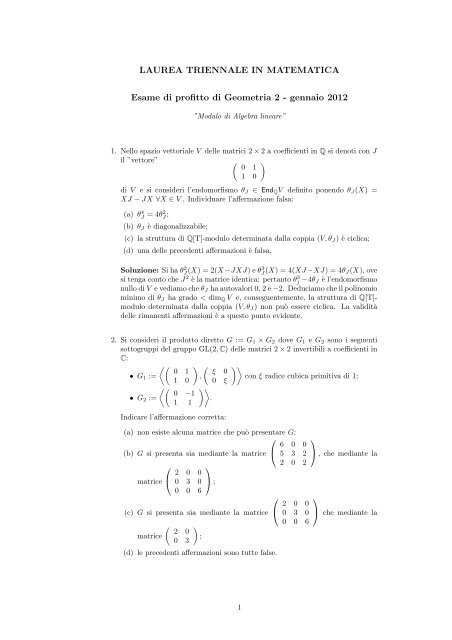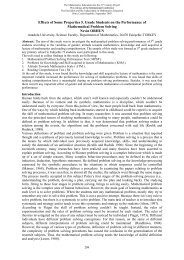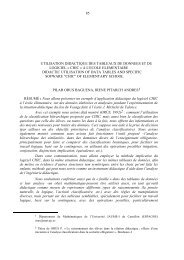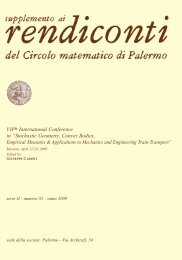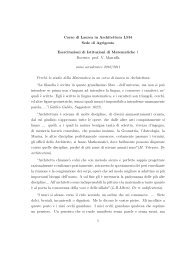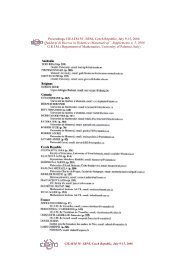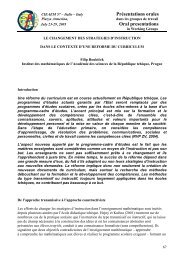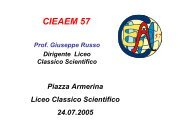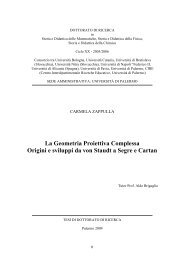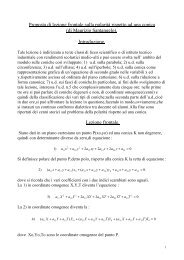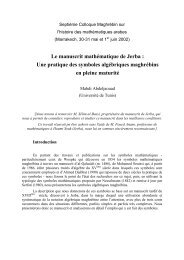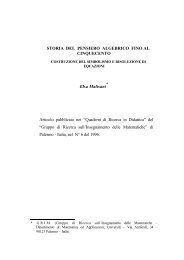Algebra lineare - Dipartimento di Matematica e Informatica
Algebra lineare - Dipartimento di Matematica e Informatica
Algebra lineare - Dipartimento di Matematica e Informatica
You also want an ePaper? Increase the reach of your titles
YUMPU automatically turns print PDFs into web optimized ePapers that Google loves.
LAUREA TRIENNALE IN MATEMATICA<br />
Esame <strong>di</strong> profitto <strong>di</strong> Geometria 2 - gennaio 2012<br />
”Modulo <strong>di</strong> <strong>Algebra</strong> <strong>lineare</strong>”<br />
1. Nello spazio vettoriale V delle matrici 2 × 2 a coefficienti in Q si denoti con J<br />
il ”vettore” <br />
0 1<br />
<br />
1 0<br />
<strong>di</strong> V e si consideri l’endomorfismo θJ ∈ EndQV definito ponendo θJ(X) =<br />
XJ − JX ∀X ∈ V . In<strong>di</strong>viduare l’affermazione falsa:<br />
(a) θ 4 J = 4θ2 J ;<br />
(b) θJ è <strong>di</strong>agonalizzabile;<br />
(c) la struttura <strong>di</strong> Q[T]-modulo determinata dalla coppia (V, θJ) è ciclica;<br />
(d) una delle precedenti affermazioni è falsa.<br />
Soluzione: Si ha θ 2 J (X) = 2(X −JXJ) e θ3 J (X) = 4(XJ −XJ) = 4θJ(X), ove<br />
si tenga conto che J 2 è la matrice identica: pertanto θ 3 j −4θJ è l’endomorfismo<br />
nullo <strong>di</strong> V e ve<strong>di</strong>amo che θJ ha autovalori 0, 2 e −2. Deduciamo che il polinomio<br />
minimo <strong>di</strong> θJ ha grado < <strong>di</strong>mQ V e, conseguentemente, la struttura <strong>di</strong> Q[T]modulo<br />
determinata dalla coppia (V, θJ) non può essere ciclica. La vali<strong>di</strong>tà<br />
delle rimanenti affermazioni è a questo punto evidente.<br />
2. Si consideri il prodotto <strong>di</strong>retto G := G1 × G2 dove G1 e G2 sono i seguenti<br />
sottogruppi del gruppo GL(2, C) delle matrici 2 × 2 invertibili a coefficienti in<br />
C:<br />
<br />
0 1<br />
• G1 :=<br />
1 0<br />
<br />
0 −1<br />
• G2 :=<br />
1 1<br />
<br />
ξ 0<br />
,<br />
<br />
.<br />
0 ξ<br />
In<strong>di</strong>care l’affermazione corretta:<br />
<br />
con ξ ra<strong>di</strong>ce cubica primitiva <strong>di</strong> 1;<br />
(a) non esiste alcuna matrice che può presentare G;<br />
⎛<br />
6 0<br />
(b) G si presenta sia me<strong>di</strong>ante la matrice ⎝ 5 3<br />
0<br />
2<br />
⎞<br />
⎠ , che me<strong>di</strong>ante la<br />
⎛<br />
2 0 0<br />
⎞<br />
2 0 2<br />
matrice ⎝ 0 3 0 ⎠ ;<br />
0 0 6<br />
(c) G si presenta sia me<strong>di</strong>ante la matrice<br />
⎛<br />
2<br />
⎝ 0<br />
0<br />
3<br />
0<br />
0<br />
⎞<br />
⎠ che me<strong>di</strong>ante la<br />
<br />
2<br />
matrice<br />
0<br />
0<br />
3<br />
<br />
;<br />
0 0 6<br />
(d) le precedenti affermazioni sono tutte false.<br />
1
Soluzione: Gli elementi che generano G1 hanno periodo 2 e 3, per cui G1 <br />
Z2⊕Z3, mentre il generatore <strong>di</strong> G2 ha periodo 6 cosicché G2 Z6. Ne consegue<br />
che G si presenta me<strong>di</strong>ante la matrice<br />
⎛<br />
⎝<br />
2 0 0<br />
0 3 0<br />
0 0 6<br />
⎞<br />
⎠ (1)<br />
che è la matrice che si può ottenere <strong>di</strong>agonalizzando opportunamente<br />
⎛<br />
6<br />
⎝ 5<br />
0<br />
3<br />
⎞<br />
0<br />
2 ⎠ .<br />
2 0 2<br />
D’altronde le righe della (1) sono linearmente in<strong>di</strong>pendenti ed i suoi coefficienti<br />
non sono invertibili, per cui la (1) non può essere ridotta ad una matrice 2 × 2.<br />
3. Sia V il sottospazio <strong>di</strong> C[x] dei polinomi <strong>di</strong> grado al più 6. Tra i seguenti<br />
endomorfismi <strong>di</strong> V<br />
(a) ϕa : 6<br />
r=0 arx r ↦→ 5<br />
r=0 ar+1x r ; (b) ϕb : 6<br />
r=0 arx r ↦→ 6<br />
r=0 iarx r ;<br />
(c) ϕc : 6<br />
r=0 arx r ↦→ 4<br />
r=0 arx r ; (d) ϕd : 6<br />
r=0 arx r ↦→ 6<br />
r=0 a6−rx r ;<br />
in<strong>di</strong>viduare l’unico che induce su V una struttura <strong>di</strong> C[T]-modulo ciclico.<br />
Soluzione: ϕa è nilpotente <strong>di</strong> in<strong>di</strong>ce 7, ϕb ha periodo 4, ϕc è idempotente e<br />
ϕd ha periodo 2: l’unico ad avere polinomio minimo <strong>di</strong> grado 7 è dunque ϕa.<br />
4. Siano V il sottospazio <strong>di</strong> R[x] dei polinomi <strong>di</strong> grado al più 3 nell’indeterminata<br />
x e ϕ ∈ EndRV l’endomorfismo<br />
ϕ : a0+a1x+a2x 2 +a3x 3 ↦→ (αa0+βa2)+(αa1+βa3)x+(γa0+δa2)x 2 +(γa1+δa3)x 3 ,<br />
con (α, β, γ, δ) ∈ R 4 , (α, β, γ, δ) = (0, 0, 0, 0). Tra i seguenti R[T]-moduli:<br />
(a) R[T]/(T 4 );<br />
(b) R[T]/(T 2 − 1) ⊕ R[T]/(T 2 − 2);<br />
(c) R[T]/(T 2 ) ⊕ R[T]/(T 2 );<br />
(d) R[T]/(T 3 − 1) ⊕ R[T]/(T − 1);<br />
in<strong>di</strong>viduare l’unico che può dare la struttura <strong>di</strong> R[T]-modulo <strong>di</strong> V definita dalla<br />
posizione Tv = ϕ(v) ∀v ∈ V .<br />
Soluzione: La matrice che rappresenta ϕ rispetto al riferimento {1, x 2 , x, x 3 }<br />
è A 0<br />
0 A<br />
dove si è posto<br />
A :=<br />
α β<br />
γ δ<br />
Ne consegue che i <strong>di</strong>visori elementari <strong>di</strong> ϕ sono quelli <strong>di</strong> A con molteplicità<br />
doppia.<br />
2<br />
<br />
,<br />
<br />
.
5. Sia n il numero delle classi <strong>di</strong> similitu<strong>di</strong>ne delle matrici 6 × 6 a coefficienti in<br />
Q aventi come rappresentante una matrice A tale che A 6 = I6 con polinomio<br />
minimo <strong>di</strong> grado 4. In<strong>di</strong>viduare l’affermazione corretta:<br />
(a) n = 8; (b) n = 10; (c) n = 12; (d) n = 14.<br />
Soluzione: I dati garantiscono che il polinomio µA(T) è un polinomio <strong>di</strong><br />
grado 4 che <strong>di</strong>vide T 6 − 1 = (T − 1)(T + 1)(T 2 − T + 1)(T 2 + T + 1): dunque<br />
µA(T) è o (T − 1)(T + 1)(T 2 − T + 1), o (T − 1)(T + 1)(T 2 + T + 1), oppure<br />
(T 2 − T + 1)(T 2 + T + 1). Posto<br />
L :=<br />
0 −1<br />
1 1<br />
<br />
e M :=<br />
0 −1<br />
1 −1<br />
possiamo allora concludere che A è simile esattamente ad una tra<br />
⎧<br />
⎪⎨<br />
⎪⎩<br />
⎧<br />
⎪⎨<br />
⎪⎩<br />
⎧<br />
⎪⎨<br />
⎪⎩<br />
⎛<br />
⎛<br />
⎝ −1<br />
⎛<br />
⎜<br />
⎝<br />
⎛<br />
⎜<br />
⎝<br />
⎛<br />
⎝<br />
⎝ −I2<br />
⎛<br />
⎝ −I3<br />
−1<br />
⎛<br />
⎝ −1<br />
⎛<br />
⎝ −I2<br />
⎛<br />
⎝ −I3<br />
−1<br />
L<br />
⎛<br />
⎝ L<br />
L<br />
1<br />
1<br />
M<br />
I3<br />
I2<br />
1<br />
I3<br />
L<br />
I2<br />
1<br />
M<br />
M<br />
M<br />
L<br />
L<br />
L<br />
L<br />
M<br />
M<br />
M<br />
⎞<br />
⎠ ,<br />
⎞<br />
⎠<br />
⎞<br />
⎠ ,<br />
⎞<br />
⎠ ,<br />
⎞<br />
⎠ ,<br />
M<br />
⎞<br />
⎟<br />
⎠ ,<br />
⎞<br />
⎠ ,<br />
⎞<br />
⎠ ,<br />
⎞<br />
⎠ ,<br />
⎞<br />
⎟<br />
⎠ ,<br />
<br />
,<br />
se µA(T) = (T − 1)(T + 1)(T 2 − T + 1);<br />
se µA(T) = (T − 1)(T + 1)(T 2 + T + 1);<br />
se µA(T) = (T 2 − T + 1)(T 2 + T + 1).<br />
3
6. Siano dati uno spazio vettoriale V <strong>di</strong> <strong>di</strong>mensione n > 3 sul campo dei numeri<br />
reali ed un suo endomorfismo ϕ tale che ϕ + ϕ 2 − ϕ 3 = idV . In<strong>di</strong>viduare<br />
l’affermazione corretta:<br />
(a) ϕ ha nucleo non banale;<br />
(b) la struttura <strong>di</strong> R[T]-modulo definita dalla coppia (V, ϕ) è ciclica;<br />
(c) esiste un vettore non nullo <strong>di</strong> v ∈ V tale che ϕ(v) = 2v;<br />
(d) le precedenti affermazioni sono tutte false.<br />
Soluzione: La con<strong>di</strong>zione posta su ϕ ci <strong>di</strong>ce che il polinomio minimo µϕ(T)<br />
<strong>di</strong> ϕ <strong>di</strong>vide T 3 − T 2 − T + 1 = (T − 1) 2 (T + 1) per cui si ha:<br />
• ϕ è invertibile in quanto 0 non può essere ra<strong>di</strong>ce <strong>di</strong> µϕ;<br />
• la struttura <strong>di</strong> R[T]-modulo definita dalla coppia (V, ϕ) non è ciclica in<br />
quanto µϕ ha grado ≤ 3 < <strong>di</strong>mR V ;<br />
• non esiste in V alcun vettore non nullo v tale che ϕ(v) = 2v in quanto 2<br />
non può essere ra<strong>di</strong>ce <strong>di</strong> µϕ.<br />
4


